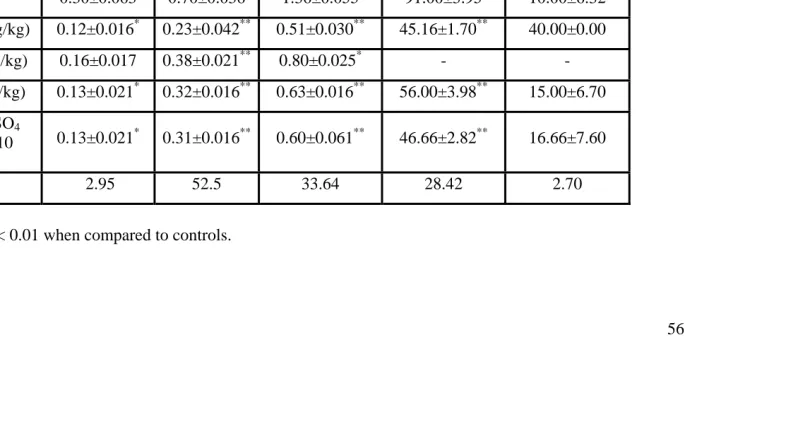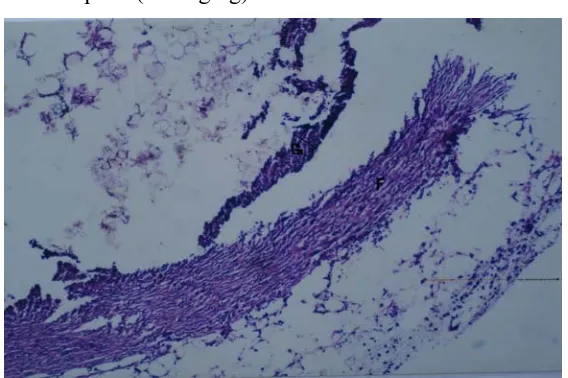ENHANCEMENT OF
ANTI-INFLAMMATORY ACTIVITY OF ASPIRIN
BY ZINC.
Vijayanand Arlalimath
*, Patil PA
**, Vivek V
****
D.S.T.S. M’s college of Pharmacy Bijapur road,
Solapur. **
Corresponding author Professor & Head
Department of Pharmacology J.N.Medical college,
Belgaum.
drpapatil@yahoo.co.in ***
J.N.Medical college, Belgaum.
Summary
Zinc an essential trace element, being an ingredient of a few pharmaceutical preaperations, has been controversially reported regarding its anti inflammatory activity. The present study plans to investigate anti inflammatory activity of zinc and its interaction with aspirin, a commonly used NSAID with regard to its anti inflammatory and ulcerogenic activity.
Doses of 5,10mg/kg failed, where as 40mg/kg showed significant anti inflammatory activity as did aspirin 200mg/kg. However zinc 10mg/kg, combined with the sub anti inflammatory dose of aspirin (54mg/kg), significantly (p<0.01) inhibited carrageenan and cotton pellet induced inflammation without significantly changing gastric ulcer index.
Synergistic anti inflammatory activity of zinc with aspirin permits to reduce the latter’s anti inflammatory dose and there by minimizes its gastrotoxicity. Confirmation of similar beneficial synergistic activity, in humans may lead to clinical exploitation of such a beneficial interaction.
Key words: aspirin, gastrotoxicity, inflammation, synergism, zinc.
Introduction
Zinc an essential trace element involved in several enzyme system implies its multiple physiological roles, such as release inhibition of histamine, serotonin as well as suppression of platelet aggregation, inhibition of calcium action and macrophage migration due to free radical injury etc.1 These actions of ZnSO4 indicate its possible role in suppression of inflammation.
In view of these controversial reports the present study was planned to elicit the anti inflammatory activity of zinc in acute as well as sub acute models of inflammation in Wistar rats. Also an attempt has been made to elicit the influence of zinc on anti-inflammatory activity of aspirin in both the models of inflammation. Since most of NSAIDs are known to produce gastric ulcerogenecity, the influence of zinc on such activity of aspirin has also been probed in the present study.
Methods
Wistar rats of either sex weighing 130-250 g, were acclimatized to the laboratory for about a week in 12:12hr light and dark cycle. They were starved over night with free access to water ad-lib prior to experimental procedures. For anti-inflammatory activity two models of inflammation viz. carrageenan induced paw edema (acute inflammation) and foreign body (grass pith and cotton pellet) induced granuloma formation (sub acute inflammation) were employed.
Acute inflammation was produced by injecting 0.05ml of 1% carrageenan as described by Winter et al7. Modified standard technique of D’Arcy as described in earlier literature8 was employed to induce sub acute inflammation by implanting 2 sterile cotton pellets (10mg each) and 2 sterile grass piths (25x3mm) sub-cutaneously in axillae/groin randomly under light ether anaesthesia with strict aseptic precautions.
In acute inflammation studies, 30min prior to carrageenan injection aspirin 200mg/kg, zinc sulfate 20mg/kg and 40mg/kg, zinc sulfate 10mg/kg and aspirin 54mg/kg together were administered orally in a single dose to different groups (n=6, in each) of animals in a volume of 10ml/kg. In subacute studies all the treatments except zinc sulfate 20mg/kg were similarly administered and treatment was repeated every 24hrs for 10 days. Control animals in both models of inflammation received equal volume of 1% gum acacia suspension, PO.
Carrageenan injected paw volume was measured at 0 (immediately after injection), 1, 3 & 6 hours after injection in all groups with help of plethysmometer (mercury displacement) and the actual edema volume was calculated by subtracting initial (0 hr) reading from subsequent corresponding readings. The percentage inhibition of paw edema was calculated using formula
Percentage inhibition = 100(1-Vt/Vc) Vc - edema volume in control while Vt - edema volume in treated groups.
The foreign body implanted animals were sacrificed on day 11 by over anaesthesia to dissect out the foreign body granulomas and stomachs. Ten day old cotton pellet granulomas were dried over night at 60oC in an incubator to note their dry weight and the same was expressed as mg/100gm body weight as suggested by Dipasquale & Meli9. Grass pith induced granulomas were preserved in 10% formalin for their histopathological studies. The stomach of control as well as treated animals were opened along with greater curvature and after gently cleaning with normal saline the ulcer index was calculated as described by Gupta et al.10 The preserved granulomas were sectioned and stained with hematoxylin and eosin (H&E) for microscopic quantification of granulation tissue. The results were statistically analysed by ANOVA followed by Dunnet’s test.
The study was approved by IAEC, constituted as per the guidelines of CPCSEA.
Results
There was significant (p<0.01) inhibition of carrageenan induced rat paw edema by aspirin 200mg/kg. Paw edema was also significantly inhibited in animals treated with zinc sulphate 20mg/kg (p<0.05), 40mg/kg (p<0.01) and zinc sulphate (10mg/kg) together with aspirin (54mg/kg, p<0.01). The anti inflammatory activity was consistent throughout the study hours in all the treated groups (table 1). Percentage inhibition was 50.37 in aspirin 200mg/kg, 38.46 in zinc sulfate 40mg/kg and 48.72 in aspirin + zinc sulfate group, which was almost comparable to that of aspirin.
The mean dry weight (mg% body weight) of 10 day old cotton pellet granuloma was significantly (p<0.01) reduced in animals treated with aspirin 200mg/kg (p<0.01), zinc sulfate 40mg/kg. Combination treatment with SAI doses of zinc sulfate and aspirin also significantly (p<0.01) reduced granuloma formation (table 1).
Histopathological studies of granulation tissue sections stained with H & E revealed scanty fibroblast population, reduced collagen deposition and markedly decreased thickness of granulation tissue in all the treated groups as compared to control group (fig 1). These microscopic observations support the anti inflammatory activity determined by granuloma dry weight.
Table 1 Effects of various treatments on inflammation and ulcer index.
*
P < 0.05 ** P < 0.01 when compared to controls.
Carrageenan induced paw edema
1 hr 3 hr 6 hr
Granuloma
(dry weight
mg%)
Ulcer index
(gastric
mucosa)
Control 0.30±0.063 0.70±0.036 1.36±0.055 91.00±3.95 10.00±6.32
Aspirin(200 mg/kg) 0.12±0.016* 0.23±0.042** 0.51±0.030** 45.16±1.70** 40.00±0.00
Z nSO4 (20 mg/kg) 0.16±0.017 0.38±0.021** 0.80±0.025* - -
ZnSO4 (40 mg/kg) 0.13±0.021* 0.32±0.016** 0.63±0.016** 56.00±3.98** 15.00±6.70
Aspirin + ZnSO4
(54mg/kg + 10 mg/kg)
0.13±0.021* 0.31±0.016** 0.60±0.061** 46.66±2.82** 16.66±7.60
Figure 1. Photomicrographs of granulation tissue stained with H&E (40 X) of control and drug treated groups.
a. Control
b. Aspirin (200mg/kg)
c. zinc sulphate (40 mg/kg)
Discussion
Findings of the present study clearly indicate that zinc sulphate in higher doses (20 & 40mg/kg) has significant anti inflammatory activity in carrageenan induced inflammation and is in agreement with earlier reports2,6. The suppression of foreign body granuloma by zinc sulphate (40mg/kg) as observed in the present study agrees with an earlier report3. Synergistic anti-inflammatory activity of zinc sulfate with aspirin as observed in the present study has not been reported, though zinc sulfate has been shown to produce beneficial additive anti-inflammatory activity when coadministered with indomethacine and diclofenac2.
SAI dose of zinc sulfate when combined with that of aspirin (54mg/kg), potentiated anti-inflammatory activity of the latter in both the models of inflammation in the present study. The anti-inflammatory activity of this combination was almost comparable to that of aspirin 200mg/kg and the interaction appears to be of pharmacodynamic nature. However the possibility of pharmacokinetic interaction can not be ruled out, since the plasma levels of zinc sulfate and aspirin have not been monitored. Based on earlier studies several mechanisms like inhibition of mast cell degranulation3, histamine/ serotonin release, calcium action and prevention of free radical injury1 could be proposed to explain anti-inflammatory activity of zinc sulfate.
Higher dose (40mg/kg) of zinc sulfate produced significant (p<0.01) anti-inflammatory activity which was comparable to that of aspirin, but without significant change in gastric ulcer index as compared to that of control group. This finding indicates that zinc sulfate does not have deleterious effects on gastric mucosa.
Though zinc sulphate and other zinc preparations have been established as pro-healing agents the mechanism involved in promoting the healing of ulcers appears to be ill-understood. The gastro protective and prohealing action of zinc sulfate has been suggested to be due to its ability to maintain gastric mucosal blood flow probably by its calcium blocking property,15,16 and by its influence on synthesis and actions of prostaglandins17. Moreover impaired prostaglandin synthesis of gut in zinc deficient rats has been reported18.
It is clear from the findings of the present study that, small amount of zinc if co-administered reduces the requirement of aspirin for its anti-inflammatory activity. Decreased dose of aspirin could also be contributing for lesser incidence of gastric ulcer index. The findings of the present study, if could be extrapolated to clinical situation, it is obvious that combination in small amounts of zinc sulfate and aspirin could produce effective anti-inflammatory response without significant gastrotoxicity. However such a possibility needs to be confirmed clinically.
Acknowledgement
The authors are grateful to the Principal, J. N. Medical College, Belgaum for providing facilities and Dr. P. R. Malur, Professor of Pathology for his guidance in microscopic studies. Thanks to Mr. Mallapur, Biostastician, Mr. A. V. Karvekar and Mr. M. D. Kankanwadi for their skilful assistance.
References

